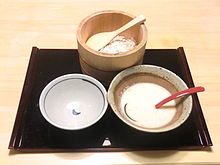Dioscorea japonica
| Dioscorea japonica | |
|---|---|

| |
| Scientific classification | |
| Kingdom: | Plantae |
| Clade: | Tracheophytes |
| Clade: | Angiosperms |
| Clade: | Monocots |
| Order: | Dioscoreales |
| Family: | Dioscoreaceae |
| Genus: | Dioscorea |
| Species: | D. japonica
|
| Binomial name | |
| Dioscorea japonica Thunb. 1784
| |
Dioscorea japonica, known as East Asian mountain yam,[1] yamaimo, or Japanese mountain yam, is a type of yam (Dioscorea) native to Japan (including Ryukyu and Bonin Islands), Korea, China, Taiwan, and Assam.[2][3]
Dioscorea japonica is used for food. Jinenjo, also called the wild yam, is a related variety of Japanese yam that is used as an ingredient in soba noodles.

Names
[edit]In Japanese, it is known as yamaimo (山芋, "mountain yam").[4] Jinenjo (自然薯, "wild yam") is another kind of Dioscorea japonica, which is native to fields and mountains in Japan.
In Chinese, Dioscorea japonica is known as yě shānyào (野山藥) which translates to English as "wild Chinese yam" or simply "wild yam".[citation needed] Another name is Rìběn shǔyù (日本薯蕷; literally "Japanese yam").[3]
In Korean, it is known as cham ma (참마), as well as dang ma (당마).[citation needed]
Chemistry
[edit]Dioscorea japonica contains the antimutagenic compounds eudesmol and paeonol.[5]
Varieties
[edit]Several formal botanical varieties have been proposed. Four are accepted:[2][3]
- Dioscorea japonica var. japonica - Japan (Ryukyu, Bonin), Korea, Taiwan, China (Anhui, Fujian, Guangdong, Guangxi, Guizhou, Hubei, Hunan, Jiangsu, Jiangxi, Sichuan, Zhejiang)
- Dioscorea japonica var. nagarum Prain & Burkill - India (Assam)
- Dioscorea japonica var. oldhamii R.Knuth - China (Guangdong, Guangxi), Taiwan
- Dioscorea japonica var. pilifera C.T.Ting & M.C.Chang - China (Anhui, Fujian, Guangxi, Guizhou, Hubei, Hunan, Jiangsu, Jiangxi, Zhejiang)
Uses
[edit]In Japanese cuisine, both the Japanese yam and the introduced Chinese yam are used interchangeably in dishes and recipes.[6]
See also
[edit]- Tororo (food), a Japanese dish made from grating raw yams such as yamaimo
References
[edit]- ^ English Names for Korean Native Plants (PDF). Pocheon: Korea National Arboretum. 2015. p. 442. ISBN 978-89-97450-98-5. Retrieved 4 January 2017 – via Korea Forest Service.
- ^ a b Kew World Checklist of Selected Plant Families
- ^ a b c "Dioscorea japonica in Flora of China @ efloras.org". Missouri Botanical Garden, St. Louis, MO & Harvard University Herbaria, Cambridge, MA. Retrieved 21 January 2012.
- ^ Ohwi, Jisaburo (1965). Meyer, Frederick G.; Walker, Egbert H. (eds.). Flora of Japan. Washington, DC: Smithsonian Institution. p. 314. OCLC 742327504. Retrieved 21 January 2012.
- ^ Antimutagenic Activity of (+)-β-Eudesmol and Paeonol from Dioscorea japonica. Mitsuo Miyazawa, Hideo Shimamura, Sei-ichi Nakamura and Hiromu Kameoka, J. Agric. Food Chem., 1996, 44 (7), pages 1647–1650, doi:10.1021/jf950792u
- ^ Itoh, Makiko (2015-07-15). "'Yamaimo': Japan's slimy mountain yam". The Japan Times. Retrieved 2019-06-07.
Text is available under the CC BY-SA 4.0 license; additional terms may apply.
Images, videos and audio are available under their respective licenses.
